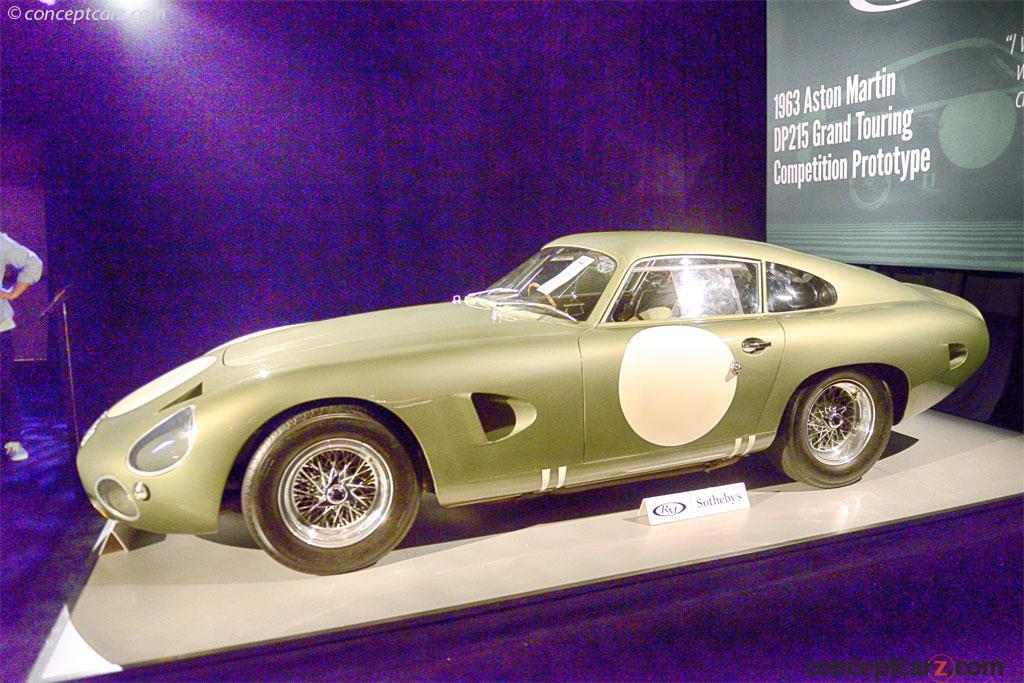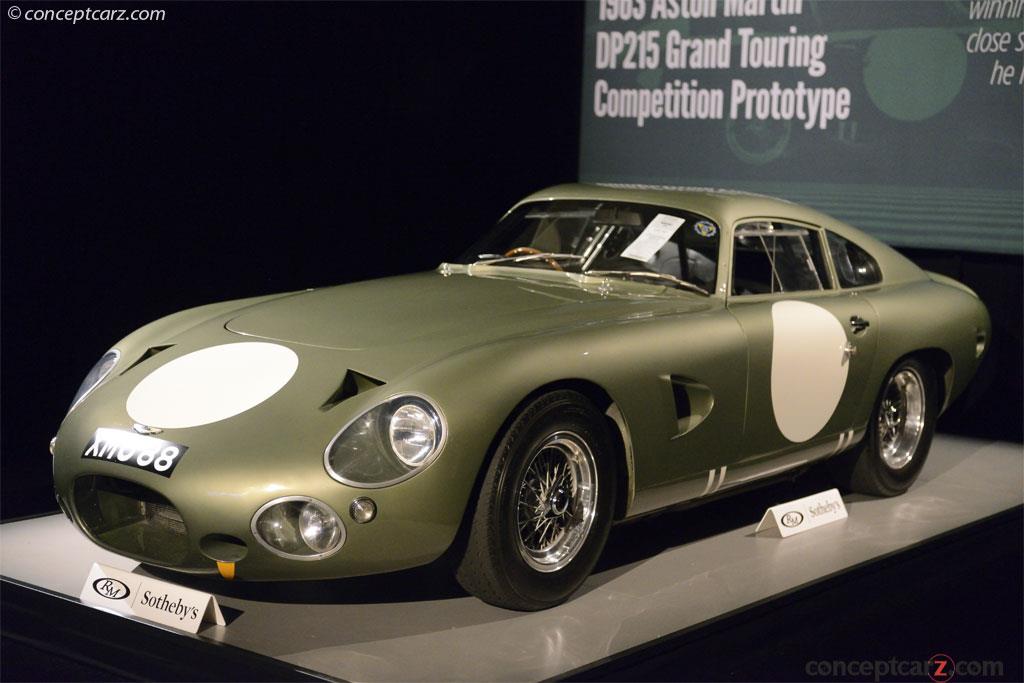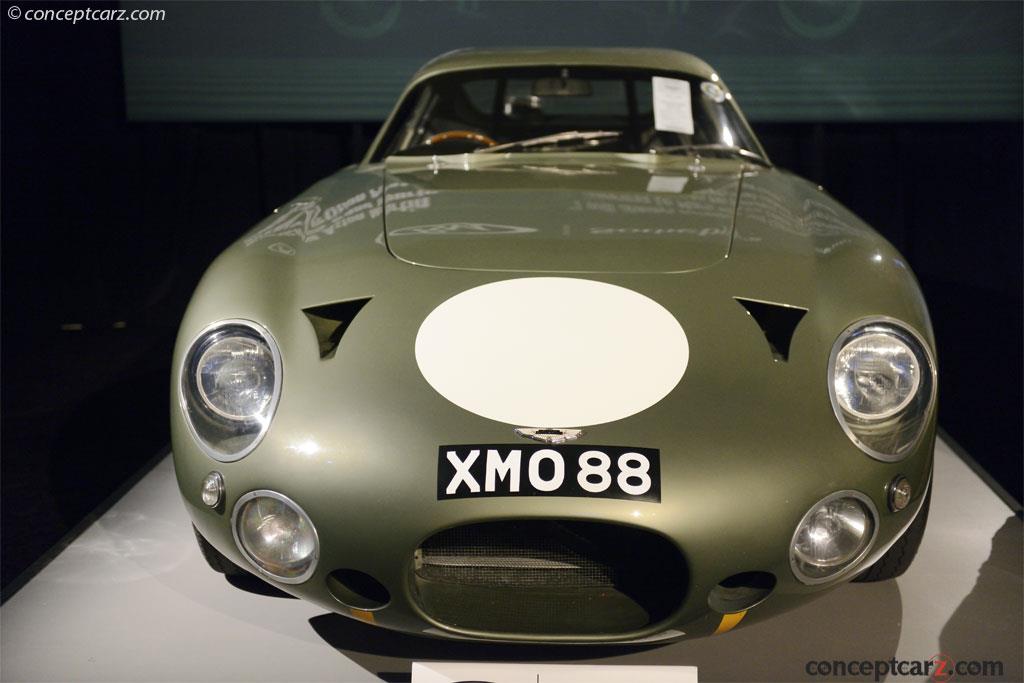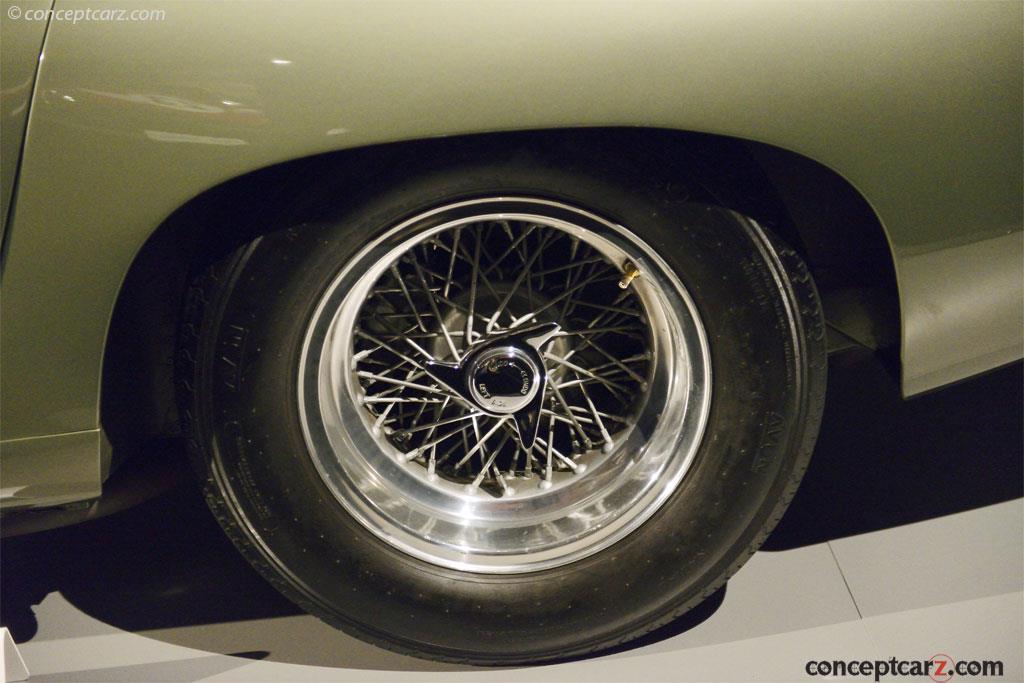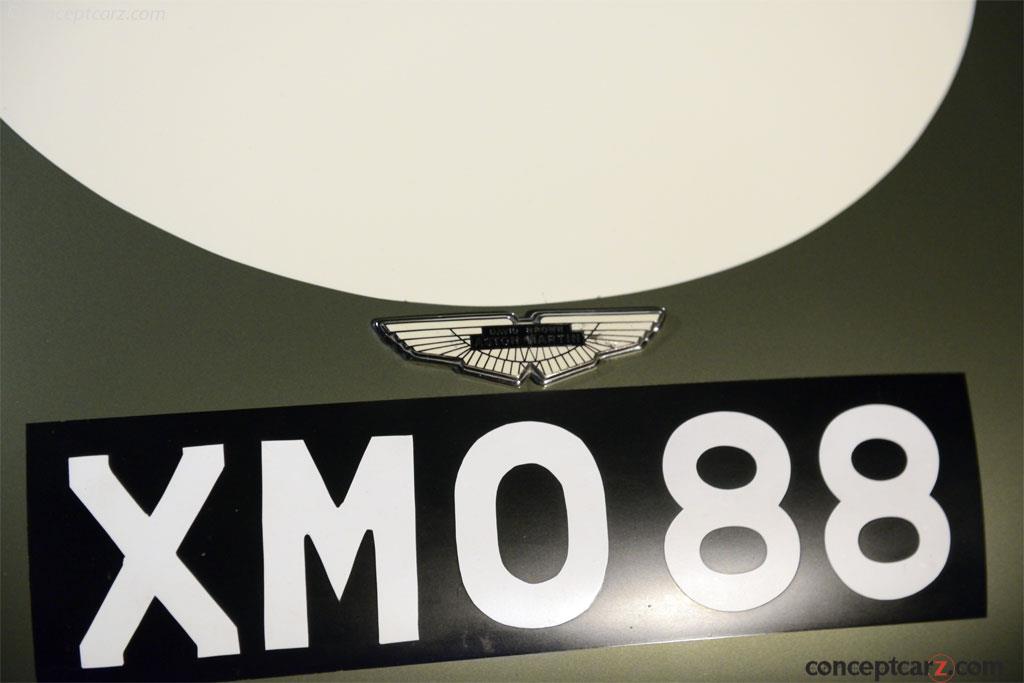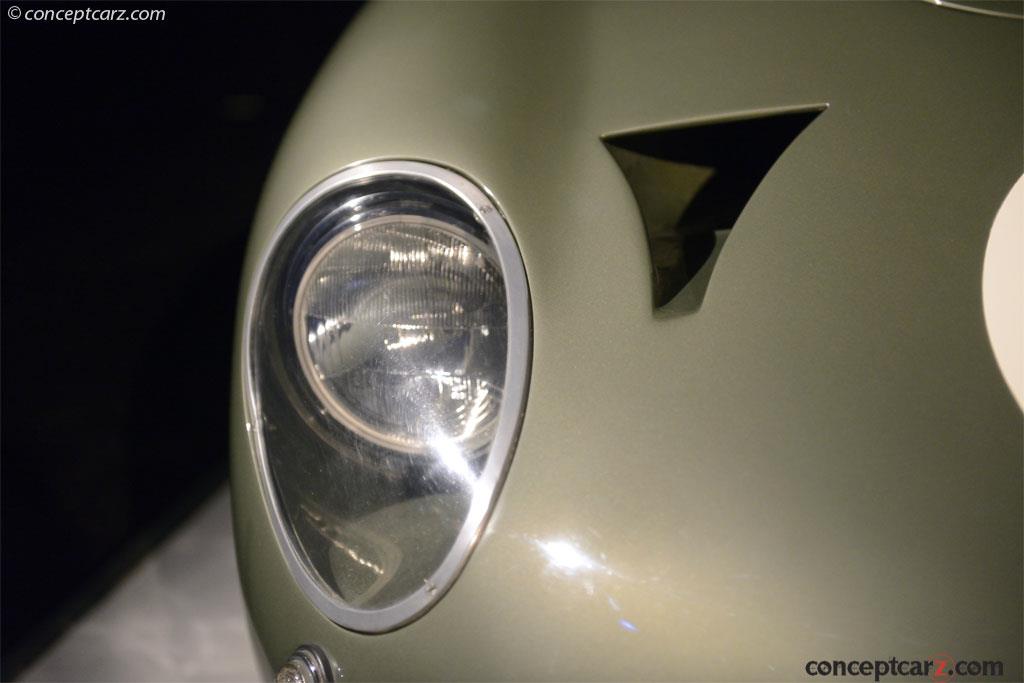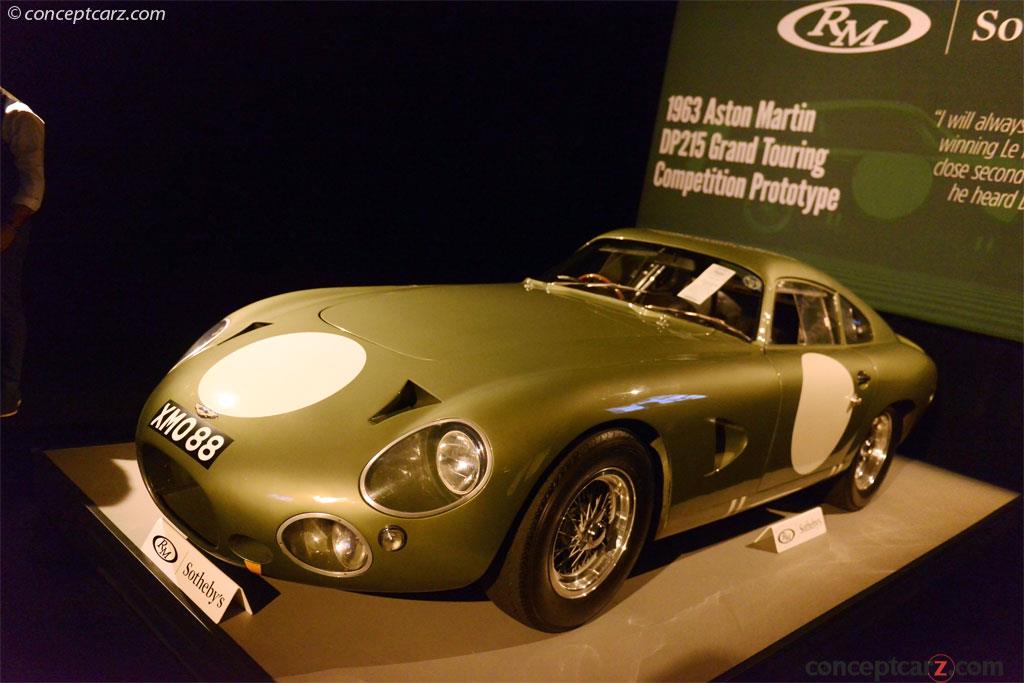Image credit: © conceptcarz.com (Reproduction Or reuse prohibited).
Between 1959 and 1963 there were 75 examples of the DB GT with coachwork by Touring. The DB4 sports car had been introduced at the 1958 London Motor Show with the GT version introduced the following year at the same show. It had been proved in competition earlier that year when the prototype 'DP/199' driven by Stirling Moss won its first race at Silverstone.
The Aston Martin DB4GT, a shortened and lightened version of the DB4. The GT is distinguished from the DB4 by an enlarged air scoop and faired-in headlights. Modifications to the GT included 5-inches off the standard wheelbase and the rear seats were replaced with a luggage platform. There was lighter, 18-gauge bodywork. All these changes helped reduce the car by around 200 lbs. It was one of the first cars to go from zero to one hundred miles per hour and to stop again in under 30 seconds. The DB4 was also the first to be built at the company's Newport Pagnell works in Buckinghamshire, England.
The engine received much attention. When equipped with a twin-plug cylinder head and triple Weber 45DCOE carburetors, it produced just over 300 bhp at 6,000 RPM. This was a significant increase over the standard 240 BHP engine. Girling were used to bring this performance monster to a stop. There was a choice of five rear axle ratios and a Power Lok limited slip differential.
The front end of the car had faired-in headlamps with Perspex covers. The rear screen and quarter windows also were made of Perspex on many examples. Wind-down windows were frame-less within the doors. Sitting atop the rear wings were twin, quick-release, Monza competition fuel over-fillers. This led to a 30-gallon fuel tank mounted flat in the trunk, which it shared with the spare wheel. The GT cars came standard with lightweight Borrani 42-spoke wire wheels with alloy rims and three-eared 'Knock-offs.'
The interior featured Connolly leather upholstery and Wilton carpeting. The instrumentation cluster had the addition of an oil temperature gauge.
In competition, the DB4 GT, campaigned by the Works team and John Ogier's Essex Racing Stable enjoyed numerous victories. In the capable hands of drivers such as Roy Salvadori, Stirling Moss, Jim Clark and Innes Ireland, the DB4 GT often set the pace of the race.
At Le Mans in 1960, Aston Martin had high hopes for their DB4 GT cars. Unfortunately for them, the Ferrari 250 GT SWBs took the first five places in their class. Obviously, more work was required to make the DB4 GT's even more competitive.
Italian Coachbuilder Zagato of Milan was commissioned to design and build 19 examples of the DB4 GT which would be used to compete against the Ferrari 250 SWB Berlinetta Coupes in international competition. The Zagato-built DB4 GT's were lighter and better prepared for racing, but were still unable to beat the Ferraris.
For 1962, Aston Martin began work on a new version of the DB4 GT which would compete under the new four litre prototype rules. It was called the DP212 and was the first of four 'project cars' produced by Aston Martin. The DP212 was lighter and used more aluminum for the chassis when compared with the DB4 GT. It was given a completely new body. Under the bonnet, the engine was bored out and the compression was increased. Horsepower was in the neighborhood of 345 BHP. In the back of the car was a DeDion suspension setup.
At LeMans, the DP212 arrived with very little test and development time under its belt. It had stiff competition, again from Ferrari, who had converted one of their 250 TR racers to comply with the new regulations, resulting in the 330 TRI/LM.
Richie Ginther and Graham Hill were given driving duties for the DP212. At the start of the race, the DP212 quickly showed its potential by leading the field. But the race is a long and grueling event; the DP212 lost precious time with small problems and was later forced to retire after a piston broke. Ferrari would finish the race and capture the checkered flag.
The DP212 had shown that it was capable of winning, or at least competing for podium finishes. Three new cars were built for 1963. Two DP214 models were built for the GT class and a single DP215 was built to contest the overall victory. Powering the GT cars were a 3.7 liter version of the Aston Martin straight six. The DP215 had a slightly larger engine.
The DP214 cars made their racing debut at LeMans where they both were forced to retire prematurely due to piston problems. The cars were fixed and continued to compete throughout the remainder of the season with victories being earned at Monza and Monthlery. At the close of the season, Aston Martin ended the program and both cars were sold to the Dawnay Racing Team. The cars continued to race, with minor victories being achieved. One example was nearly destroyed in an accident at the Nürburgring and was later scrapped. The only example to remain is chassis number 0194.
The Aston Martin Design Project known as DP215 was the ultimate evolution of the Aston Martin GT racers and was the final racing car built by the factory. It was designed by Chief Engineer Ted Cutting, was powered by an engine from Tadek Marek, and was ordered by John Wyer. Phil Hill and Lucien Bianchi were given driven duties at the 1963 LeMans where it raced the in the Prototype Class.
DP215 was ordered in March, just two months prior to the LeMans event. DP215 was similar in appearance to the two prior DP214s, but was very different mechanically. Ted Cutting understood the importance of aerodynamics and balance through years of wind-tunnel testing at MIRA. Power was from a four-liter version of the DP212 six-cylinder twin plug engine with a dry sump oil system. The steel box-frame chassis was modified to allow the engine to be fitted a full 10 inches further back than in DP212. In the back was an independent rear suspension setup.
On the Mulsanne Straight at the 24 Hours of Le Mans, DP215 recorded a speed of 198.6 mph and could had gone faster if there were more real estate. Unfortunately, the car retired after just two hours due to a failure with the DBR1-type CG537 gearbox caused by the high torque of the four-liter engine.
The car was quickly repaired and entered the next month at Reims where it was driven by Jo Schlesser. The car was once again one of the quickest cars on the course, however it would fail to make it to the finish line. Schlesser missed a gear and over-revved the engine.
After the race, DP215 was given the engine it was originally tended for the car - the S532. In this guise, it was entered in the 1963 Brands Hatch Guards Trophy, but would not see the start line due to tax regulations.
In November 1963, and following the resignation of John Wyer, the British press reported the Aston Martin Racing Department officially closed. Aston Martin sold the team cars but kept DP215 for development in hopes of returning to competition in 1965. Those hopes came to an end when DP215 was involved in an accident during night testing on the M1 motorway.
In 1974, Aston Martin sold the car to Malcolm Calvert. By this point in history, DP215 had lost some of its original parts. The four-liter engine had been sold to privateer Colin Crabbe for his DP215, and the rare S532 gearbox was lost to time.
Calvert embarked on a long-term restoration project which would eventually span several owners. The factory fit the original, 1963 Works DP214/215 spare body on what was a slightly bent chassis. When the car left the factory, it retained the original suspension, rear differential unit, dashboard, instruments, pedals, etc.
With intentions of transforming the car into a road (rather than race) car, Calvert installed a DB6 engine and ZF gearbox. Calvert used the car for several years before selling it in April of 1978. It was purchased by Nigel Dawes who continued the restoration with help and guidance from Ted Cutting, the original designer.
After years of searching, the original engine was found in DP214, which had been converted to wet sump. Instead, Dawes managed to obtain the Indianapolis Cooper-Aston 4.2-liter engine. Modifications were performed on the engine by Forward Engineering, making it a dry sump setup, and bringing it as close to the original as was possible.
In 1996, after the car was completely restored, Nigel Dawes sold the car to Anthony J. Smith. Mr. Smith used the car on several outings including the Goodwood Festival of Speed and TT Revival.
In 2002, the current caretaker traded a Formula 1 Ferrari for the DP215. The new owner and his son contacted Ted Cutting requesting help to rebuild a brand-new correct-type S532 transmission following Ted's original plans and the box from DP212. The process involved crafting over 1,000 parts that make up the gearbox.
One final component remained un-original to the car, and that was the engine. By this point, the original engine had spent half a century with DP214. After working out a deal, the original engine (400/215/1) was reunited with DP215. Since the installation, an estimated 300 miles have been put on the engine since an RS William rebuild in 1992.By Daniel Vaughan | Jul 2018
The Aston Martin DB4GT, a shortened and lightened version of the DB4. The GT is distinguished from the DB4 by an enlarged air scoop and faired-in headlights. Modifications to the GT included 5-inches off the standard wheelbase and the rear seats were replaced with a luggage platform. There was lighter, 18-gauge bodywork. All these changes helped reduce the car by around 200 lbs. It was one of the first cars to go from zero to one hundred miles per hour and to stop again in under 30 seconds. The DB4 was also the first to be built at the company's Newport Pagnell works in Buckinghamshire, England.
The engine received much attention. When equipped with a twin-plug cylinder head and triple Weber 45DCOE carburetors, it produced just over 300 bhp at 6,000 RPM. This was a significant increase over the standard 240 BHP engine. Girling were used to bring this performance monster to a stop. There was a choice of five rear axle ratios and a Power Lok limited slip differential.
The front end of the car had faired-in headlamps with Perspex covers. The rear screen and quarter windows also were made of Perspex on many examples. Wind-down windows were frame-less within the doors. Sitting atop the rear wings were twin, quick-release, Monza competition fuel over-fillers. This led to a 30-gallon fuel tank mounted flat in the trunk, which it shared with the spare wheel. The GT cars came standard with lightweight Borrani 42-spoke wire wheels with alloy rims and three-eared 'Knock-offs.'
The interior featured Connolly leather upholstery and Wilton carpeting. The instrumentation cluster had the addition of an oil temperature gauge.
In competition, the DB4 GT, campaigned by the Works team and John Ogier's Essex Racing Stable enjoyed numerous victories. In the capable hands of drivers such as Roy Salvadori, Stirling Moss, Jim Clark and Innes Ireland, the DB4 GT often set the pace of the race.
At Le Mans in 1960, Aston Martin had high hopes for their DB4 GT cars. Unfortunately for them, the Ferrari 250 GT SWBs took the first five places in their class. Obviously, more work was required to make the DB4 GT's even more competitive.
Italian Coachbuilder Zagato of Milan was commissioned to design and build 19 examples of the DB4 GT which would be used to compete against the Ferrari 250 SWB Berlinetta Coupes in international competition. The Zagato-built DB4 GT's were lighter and better prepared for racing, but were still unable to beat the Ferraris.
For 1962, Aston Martin began work on a new version of the DB4 GT which would compete under the new four litre prototype rules. It was called the DP212 and was the first of four 'project cars' produced by Aston Martin. The DP212 was lighter and used more aluminum for the chassis when compared with the DB4 GT. It was given a completely new body. Under the bonnet, the engine was bored out and the compression was increased. Horsepower was in the neighborhood of 345 BHP. In the back of the car was a DeDion suspension setup.
At LeMans, the DP212 arrived with very little test and development time under its belt. It had stiff competition, again from Ferrari, who had converted one of their 250 TR racers to comply with the new regulations, resulting in the 330 TRI/LM.
Richie Ginther and Graham Hill were given driving duties for the DP212. At the start of the race, the DP212 quickly showed its potential by leading the field. But the race is a long and grueling event; the DP212 lost precious time with small problems and was later forced to retire after a piston broke. Ferrari would finish the race and capture the checkered flag.
The DP212 had shown that it was capable of winning, or at least competing for podium finishes. Three new cars were built for 1963. Two DP214 models were built for the GT class and a single DP215 was built to contest the overall victory. Powering the GT cars were a 3.7 liter version of the Aston Martin straight six. The DP215 had a slightly larger engine.
The DP214 cars made their racing debut at LeMans where they both were forced to retire prematurely due to piston problems. The cars were fixed and continued to compete throughout the remainder of the season with victories being earned at Monza and Monthlery. At the close of the season, Aston Martin ended the program and both cars were sold to the Dawnay Racing Team. The cars continued to race, with minor victories being achieved. One example was nearly destroyed in an accident at the Nürburgring and was later scrapped. The only example to remain is chassis number 0194.
The Aston Martin Design Project known as DP215 was the ultimate evolution of the Aston Martin GT racers and was the final racing car built by the factory. It was designed by Chief Engineer Ted Cutting, was powered by an engine from Tadek Marek, and was ordered by John Wyer. Phil Hill and Lucien Bianchi were given driven duties at the 1963 LeMans where it raced the in the Prototype Class.
DP215 was ordered in March, just two months prior to the LeMans event. DP215 was similar in appearance to the two prior DP214s, but was very different mechanically. Ted Cutting understood the importance of aerodynamics and balance through years of wind-tunnel testing at MIRA. Power was from a four-liter version of the DP212 six-cylinder twin plug engine with a dry sump oil system. The steel box-frame chassis was modified to allow the engine to be fitted a full 10 inches further back than in DP212. In the back was an independent rear suspension setup.
On the Mulsanne Straight at the 24 Hours of Le Mans, DP215 recorded a speed of 198.6 mph and could had gone faster if there were more real estate. Unfortunately, the car retired after just two hours due to a failure with the DBR1-type CG537 gearbox caused by the high torque of the four-liter engine.
The car was quickly repaired and entered the next month at Reims where it was driven by Jo Schlesser. The car was once again one of the quickest cars on the course, however it would fail to make it to the finish line. Schlesser missed a gear and over-revved the engine.
After the race, DP215 was given the engine it was originally tended for the car - the S532. In this guise, it was entered in the 1963 Brands Hatch Guards Trophy, but would not see the start line due to tax regulations.
In November 1963, and following the resignation of John Wyer, the British press reported the Aston Martin Racing Department officially closed. Aston Martin sold the team cars but kept DP215 for development in hopes of returning to competition in 1965. Those hopes came to an end when DP215 was involved in an accident during night testing on the M1 motorway.
In 1974, Aston Martin sold the car to Malcolm Calvert. By this point in history, DP215 had lost some of its original parts. The four-liter engine had been sold to privateer Colin Crabbe for his DP215, and the rare S532 gearbox was lost to time.
Calvert embarked on a long-term restoration project which would eventually span several owners. The factory fit the original, 1963 Works DP214/215 spare body on what was a slightly bent chassis. When the car left the factory, it retained the original suspension, rear differential unit, dashboard, instruments, pedals, etc.
With intentions of transforming the car into a road (rather than race) car, Calvert installed a DB6 engine and ZF gearbox. Calvert used the car for several years before selling it in April of 1978. It was purchased by Nigel Dawes who continued the restoration with help and guidance from Ted Cutting, the original designer.
After years of searching, the original engine was found in DP214, which had been converted to wet sump. Instead, Dawes managed to obtain the Indianapolis Cooper-Aston 4.2-liter engine. Modifications were performed on the engine by Forward Engineering, making it a dry sump setup, and bringing it as close to the original as was possible.
In 1996, after the car was completely restored, Nigel Dawes sold the car to Anthony J. Smith. Mr. Smith used the car on several outings including the Goodwood Festival of Speed and TT Revival.
In 2002, the current caretaker traded a Formula 1 Ferrari for the DP215. The new owner and his son contacted Ted Cutting requesting help to rebuild a brand-new correct-type S532 transmission following Ted's original plans and the box from DP212. The process involved crafting over 1,000 parts that make up the gearbox.
One final component remained un-original to the car, and that was the engine. By this point, the original engine had spent half a century with DP214. After working out a deal, the original engine (400/215/1) was reunited with DP215. Since the installation, an estimated 300 miles have been put on the engine since an RS William rebuild in 1992.By Daniel Vaughan | Jul 2018
2018 RM Sothebys : Monterey
Pre-Auction Estimates :
USD $18,000,000-USD $22,000,000
Sale Price :
USD $21,455,000
Recent Sales of the Aston Martin DP215
(Data based on Model Year 1963 sales)
| 1963 Aston Martin DP215 Grand Touring Competition Prototype Chassis#: DP215 Sold for USD$21,455,000 2018 RM Sothebys : Monterey |   |
Aston Martin DP215s That Failed To Sell At Auction
1963 Aston Martin DP215's that have appeared at auction but did not sell.
| Vehicle | Chassis | Event | High Bid | Est. Low | Est. High |
|---|
Vehicles With Comparable Market Values
Similar sales to the $21,455,000 range.
| 1955 Ferrari 410 Sport Spider by Scaglietti Chassis#:0598 CM Sold for $22,005,000 2022 RM Sothebys : Monterey |   |
| 1995 McLaren F1 Chassis#:SA9AB5AC9S1048029 Sold for $20,465,000 2021 Gooding & Company : Pebble Beach Concours Auction |   |
| 1994 McLaren F1 'LM-Specification' Chassis#:SA9AB5AC1R1048018 Sold for $19,805,000 2019 RM Sothebys : Monterey |   |
| 1956 Ferrari 290 MM by Scaglietti Chassis#:0628 Sold for $22,005,000 2018 RM Sothebys : The Petersen Automotive Museum |   |
| 1935 Duesenberg SSJ Chassis#:2594 Sold for $22,000,000 2018 Gooding & Company : Pebble Beach |   |
| 1956 Aston Martin DBR1 Chassis#:DBR1/1 Sold for $22,500,000 2017 RM Sothebys : Monterey |   |
| 1939 Alfa Romeo 8C 2900B Lungo Spider by Touring Chassis#:412041 Sold for $19,800,000 2016 RM Sotheby's : Monterey |   |
| 1955 Jaguar D-Type Chassis#:XKD 501 Sold for $21,780,000 2016 RM Sotheby's : Monterey |   |
| 1955 Ferrari 410 Sport Chassis#:0592CM Sold for $23,000,000 2014 Rick Cole Auctions : Monterey |   |
1963 Aston Martin DP215
• Additional valuation insight and sales data• History
• Specifications
• Image gallery
• Other Aston Martin DP215 model years
